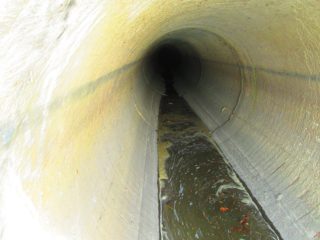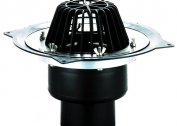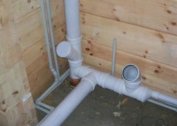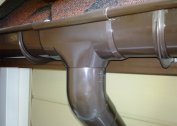Sewer systems are designed to eliminate pollution that is formed during the life of humans and animals, industrial plants, rainfall. In order to choose the right complex for a home or industrial building, you need to know the features of all types of transportation and wastewater treatment.
Destination classification
There are three classes of sewer systems:
- K1 - Household (household fecal). Conclusion of pollution associated with human life. Domestic sewage can be local, that is, it is equipped in a specific building, and centralized - citywide.
- K2 - Stormy. Removing water from surfaces formed due to rain and snow. This also includes the drainage system necessary to remove excess subsoil moisture.
- K3 - Industrial (manufacturing). Collection and cleaning of effluents in industrial complexes, food processing plants, medical and pharmaceutical institutions.
The main function of stormwater is the collection and removal of rainwater to protect the foundations, walls and roofs of houses, paved surfaces. Streams are routed through the mains to the drive, and then discharged into ponds or soil, since they are not harmful to the environment. In private households they watered garden plantings.
Sewerage drainage type equip where subsoil sources are located high to the surface and threaten swamping of the soil. Special perforated drains deepen the soil, which absorb moisture. Then it is transported to drain pits, ditches or well devices.
When creating a household network, it is taken into account that the discharge lines from the plumbing are equipped with water locks to prevent air from entering the outside. These pipes are connected to the risers, through which the drains go to a central network or a treatment device. Risers are usually made of pipes with a cross section of 100 mm, pipelines to plumbing fixtures - 50 mm.
When combined in one complex of two or three types, the system is called integrated. In residential and public buildings, household and storm sewers are usually provided. The enterprises use sewers of all types - K1, K2 and K3, but with separate drains. Do not mix liquids with different composition, temperature, aggressiveness.
Separately considered cable ducts. It is used to protect telephone and electrical wires from overloading the soil, rain and snow, as well as for ease of repair. The channels are created in such a way that there is no need for opening the soil and the destruction of the asphalt pavement.
Types of Sewerage by Localization
 All types of sewerage are divided into internal and external. The first group includes a set of sewer devices installed inside the building. These include:
All types of sewerage are divided into internal and external. The first group includes a set of sewer devices installed inside the building. These include:
- plumbing fixtures and receiving plums;
- bell-shaped trunk;
- connection elements;
- inspection hatches and wells.
The outdoor complex includes a pipeline and sewage treatment devices located outside the house, on the street. This system is divided into three varieties:
- general alloy, where any wastewater leaves in one stream;
- separate, in which storm, industrial and household effluents have their own branch;
- semi-separate, where the outlets for the effluents themselves are separate, but they merge into a single tank or treatment system.
General-purpose sewage is often used in small private homes. At enterprises, only a separate system is used.
Types of local sewage
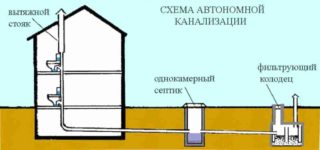 Varieties of sewer systems used by owners of private houses and summer residents rarely connect to the citywide network to drain wastewater. Usually choose a local treatment plant:
Varieties of sewer systems used by owners of private houses and summer residents rarely connect to the citywide network to drain wastewater. Usually choose a local treatment plant:
- Cesspool. The cheapest sewer system. It consists of a plastic container or a foundation pit with brick or concrete walls. A pipeline with a certain slope is brought to the tank. The disadvantage of this system is the fast filling and frequent pumping of effluents.
- Dry closet. The gardeners often install the device, since it does not require excavation and installation work, and it is not difficult to purchase the cabin itself. Microorganisms are used to clean the fecal matter. This is the minus of the design - biological products must be regularly purchased.
- Septic tank. The most popular design for private homes. Efficiency in wastewater treatment up to 80 percent is achieved through biological products. A septic tank usually includes several chambers - sealed and with a drained bottom. It is more expensive than previous devices, but quickly pays off due to minimal operating costs.
The best are considered biological biological treatment plants - expensive complexes consisting of several devices. They provide quality clarified water up to 98 percent.
Separation by wastewater disposal method
 In private estates and cottages, gravity drainage is usually used. The scheme of work is simple - the drain under the influence of gravity is directed to drives or VOCs. For this, the lines are laid with a slight bias.
In private estates and cottages, gravity drainage is usually used. The scheme of work is simple - the drain under the influence of gravity is directed to drives or VOCs. For this, the lines are laid with a slight bias.
The main advantages of the system:
- inexpensive and easy installation;
- ease of maintenance;
- non-volatility.
The disadvantage of the sewage type of sewage is that it will not be able to function normally if the treatment plant or drive is located far from the house or cottage.
The degree of slope of the highway depends on the length and cross section. On average, it is 1-3 cm per linear meter of the pipeline. If the slope is completely invisible, the drains will not be able to leave quickly, congestion will form. A large slope will lead to the deposition of greasy deposits on the tube walls, which will gradually reduce the conductivity of the system.
The second type of autonomous sewage system is pressure head. It is installed in areas where the drive is located above the weirs in the building. This happens if you have plumbing in the basement. Gravity is not possible with such a layout, you will have to connect a pumping device. In such systems, a cutting mechanism is sometimes provided to grind solid waste such as paper.
Thanks to pressure sewer systems, wastewater can be transported to remote treatment facilities located at any height.
No need to worry during the installation of the sewer about the number and shape of bends. A powerful pump will accelerate the movement of drains, and they will not get stuck in turns. The disadvantages of a pressure sewer system include volatility. It is disadvantageous to install in private homes, where there are problems with the supply of electricity.
The choice of a sewer system for a frequent house or industrial complex is determined by the purpose of the structure where the highway will be held. It also takes into account the type of sanitary equipment, the depth of the external sewer network, the composition of the wastewater and the possibility of their reuse, the layout of individual appliances and components.
